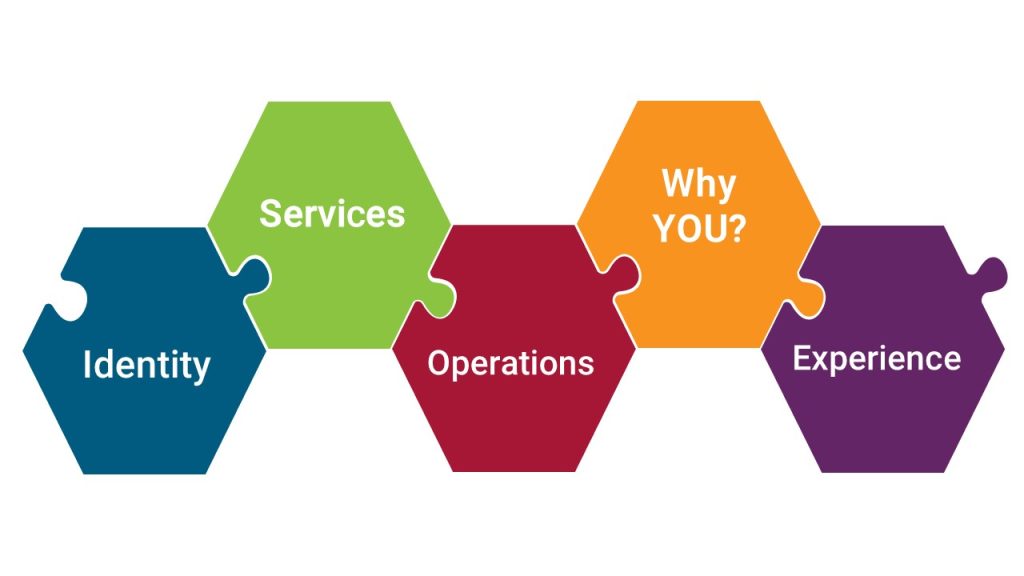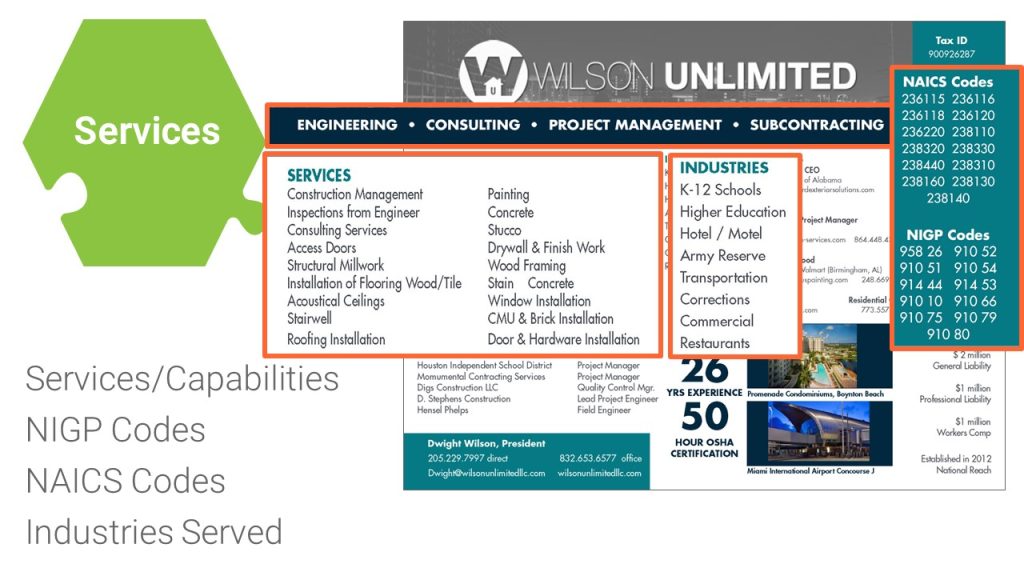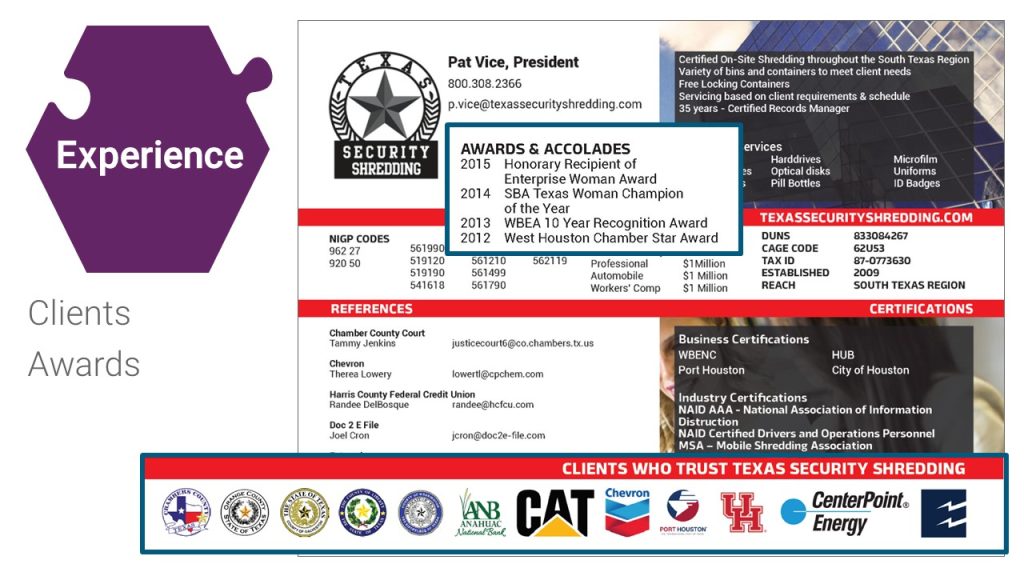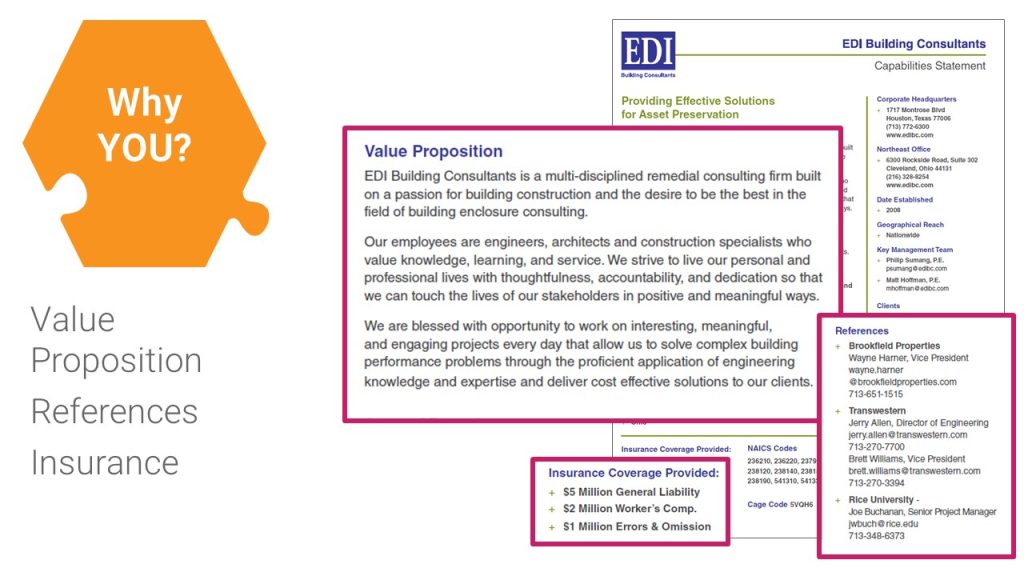
Components of a Capability Statement

Components of a Capability Statement – a concise document that outlines a company’s core competencies, achievements, and differentiators – are what defines what your company is about.
And, like a personal resume, there are key components you need to include. Buyers will be looking for these and often comparing your company against competitors to decide who may be the right fit for the job. Win them over every time by including these details and making them as strong as possible.
Here are the five key components of a great capability statement:
1. Identity

When creating a capability statement, it’s crucial to clearly present who you are and how to contact your company. Key components of a capability statement include your company name and logo, physical address, and essential contact information such as your phone number, email address, and website. It’s also important to include identifying details like your tax ID number and DUNS number, especially for government contracts.
Additionally, consider incorporating nice-to-have details such as relevant personal or company certifications, links to active social media profiles for enhanced visibility, and the name and title of your president or CEO. Including a headshot of the CEO can add a personal touch that makes your capability statement stand out. This structured approach will help you create an effective capability statement that captures attention and provides essential information.
2. Services

When it comes to explaining your services, keep things simple and focused. Emphasize your top 3-4 strengths as a company. This isn’t a time to be all things to all people.
An easy and required way to elaborate on what services your company offers is through NIGP (National Institute of Government Purchasing) and NAICS (North American Industry Classification System) codes. These codes are assigned to companies to help classify the type of work they do.
It also allows the government the ability to collect, analyze, and publish statistical data about the country’s economy. You will also want to include the industries you serve, such as K-12 education, healthcare, construction, or other types of businesses.
3. Operations

In today’s globalized world, it’s essential to highlight your geographic reach in providing goods or services. Include the locations of your warehouse, plant, or office, and if you have a single physical address, integrate this into your contact details. Showcasing your operational footprint helps potential clients and partners understand your capabilities and accessibility.
4. Experience

This is your space to highlight the companies your business has worked with. These can be highlighted in a number of ways on a capability statement. You might include their logo, with permission. Maybe you want to sum up your experience “by the numbers” and list things in an infographic, such as years in business, number of repeat clients, how many projects you’ve completed this year, or even annual sales (especially if you can show growth year after year).
Just getting started? Use your personal experience to show why you’re qualified to do this work.
This is also a great place to show off any memberships to industry organizations, including leadership positions, as well as personal or company awards, accolades, or important accomplishments.
5. Why YOU?

And finally, sell them on why your company can do the best job! If you have a clear and concise mission or value proposition, make it prominent on your capability statement. In its simplest form, a value proposition explains who you are, what problem you solve, and who you solve it for. Keep these simple, straightforward, and avoid jargon.
Here’s a helpful hint: this is also a good time to look at your competitor’s websites and figure out how you can differentiate yourself from them.
Depending on the type of work you do, including details about your insurance can help set you apart from others in the bidding process. Consider including a snapshot of things like general liability, profession liability, and worker’s comp.
Finally, include references! You should have a minimum of three people on standby at all times to serve as your reference. These should be people or companies that you would want to work with again, whose projects you were proud to compete, or who you’ve worked with repeatedly. Include their name, title, company, and preferred contact information on your capability statement.
Need help building your capability statement?
B2G Victory can help! Schedule a time on our Booking Calendar at the link below, and we’ll discuss what resources your business needs to achieve victory.
Tags:
